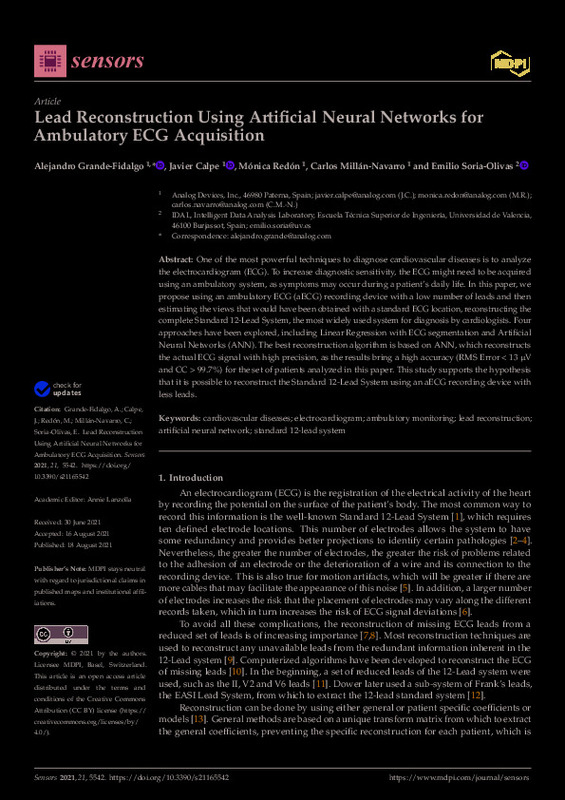JavaScript is disabled for your browser. Some features of this site may not work without it.
Buscar en RiuNet
Listar
Mi cuenta
Estadísticas
Ayuda RiuNet
Admin. UPV
Lead Reconstruction Using Artificial Neural Networks for Ambulatory ECG Acquisition
Mostrar el registro sencillo del ítem
Ficheros en el ítem
| dc.contributor.author | Grande-Fidalgo, Alejandro
|
es_ES |
| dc.contributor.author | Calpe Maravilla, Javier
|
es_ES |
| dc.contributor.author | Redón Segrera, Mónica
|
es_ES |
| dc.contributor.author | Millán-Navarro, Carlos
|
es_ES |
| dc.contributor.author | Soria Olivas, Emilio
|
es_ES |
| dc.date.accessioned | 2024-02-16T19:00:20Z | |
| dc.date.available | 2024-02-16T19:00:20Z | |
| dc.date.issued | 2021-08 | es_ES |
| dc.identifier.uri | http://hdl.handle.net/10251/202695 | |
| dc.description.abstract | [EN] One of the most powerful techniques to diagnose cardiovascular diseases is to analyze the electrocardiogram (ECG). To increase diagnostic sensitivity, the ECG might need to be acquired using an ambulatory system, as symptoms may occur during a patient¿s daily life. In this paper, we propose using an ambulatory ECG (aECG) recording device with a low number of leads and then estimating the views that would have been obtained with a standard ECG location, reconstructing the complete Standard 12-Lead System, the most widely used system for diagnosis by cardiologists. Four approaches have been explored, including Linear Regression with ECG segmentation and Artificial Neural Networks (ANN). The best reconstruction algorithm is based on ANN, which reconstructs the actual ECG signal with high precision, as the results bring a high accuracy (RMS Error < 13 ¿V and CC > 99.7%) for the set of patients analyzed in this paper. This study supports the hypothesis that it is possible to reconstruct the Standard 12-Lead System using an aECG recording device with less leads. | es_ES |
| dc.language | Inglés | es_ES |
| dc.publisher | MDPI AG | es_ES |
| dc.relation.ispartof | Sensors | es_ES |
| dc.rights | Reconocimiento (by) | es_ES |
| dc.subject | Cardiovascular diseases | es_ES |
| dc.subject | Electrocardiogram | es_ES |
| dc.subject | Ambulatory monitoring | es_ES |
| dc.subject | Lead reconstruction | es_ES |
| dc.subject | Artificial neural network | es_ES |
| dc.subject | Standard 12-lead system | es_ES |
| dc.title | Lead Reconstruction Using Artificial Neural Networks for Ambulatory ECG Acquisition | es_ES |
| dc.type | Artículo | es_ES |
| dc.identifier.doi | 10.3390/s21165542 | es_ES |
| dc.rights.accessRights | Abierto | es_ES |
| dc.description.bibliographicCitation | Grande-Fidalgo, A.; Calpe Maravilla, J.; Redón Segrera, M.; Millán-Navarro, C.; Soria Olivas, E. (2021). Lead Reconstruction Using Artificial Neural Networks for Ambulatory ECG Acquisition. Sensors. 21(16). https://doi.org/10.3390/s21165542 | es_ES |
| dc.description.accrualMethod | S | es_ES |
| dc.relation.publisherversion | https://doi.org/10.3390/s21165542 | es_ES |
| dc.type.version | info:eu-repo/semantics/publishedVersion | es_ES |
| dc.description.volume | 21 | es_ES |
| dc.description.issue | 16 | es_ES |
| dc.identifier.eissn | 1424-8220 | es_ES |
| dc.identifier.pmid | 34450984 | es_ES |
| dc.identifier.pmcid | PMC8401493 | es_ES |
| dc.relation.pasarela | S\445257 | es_ES |








